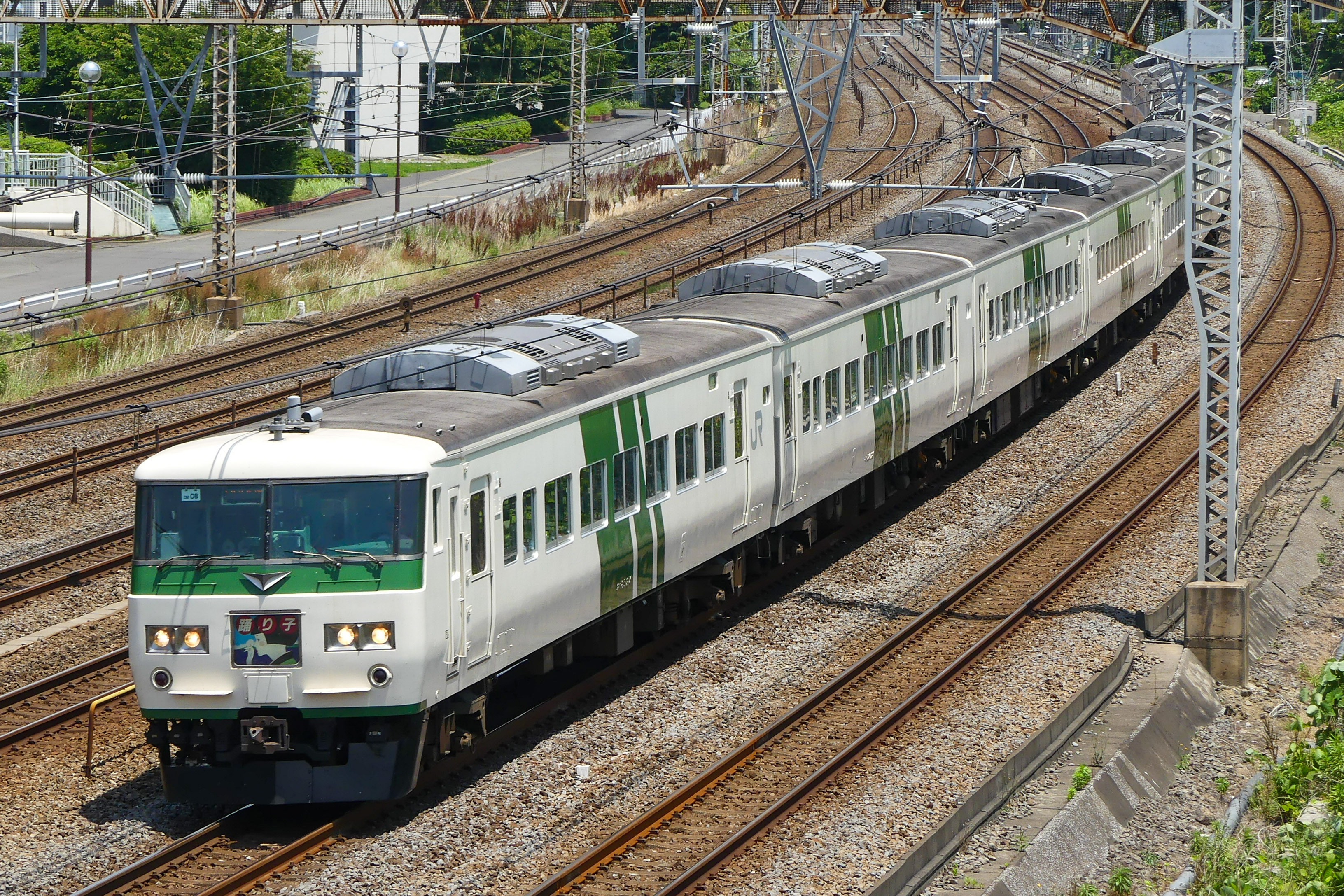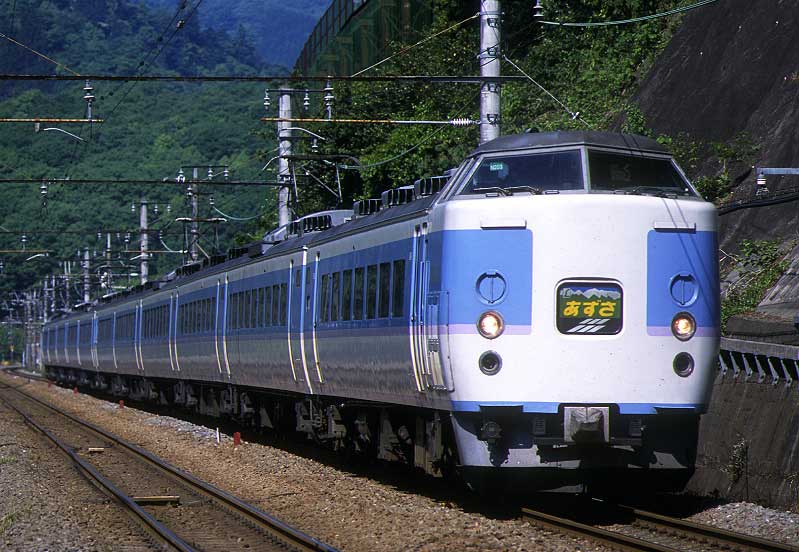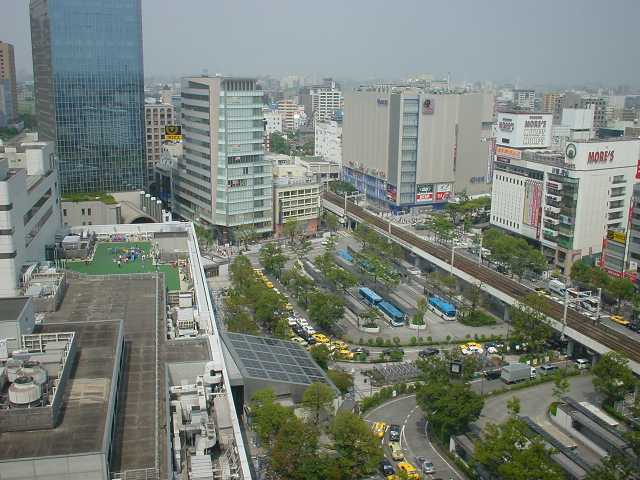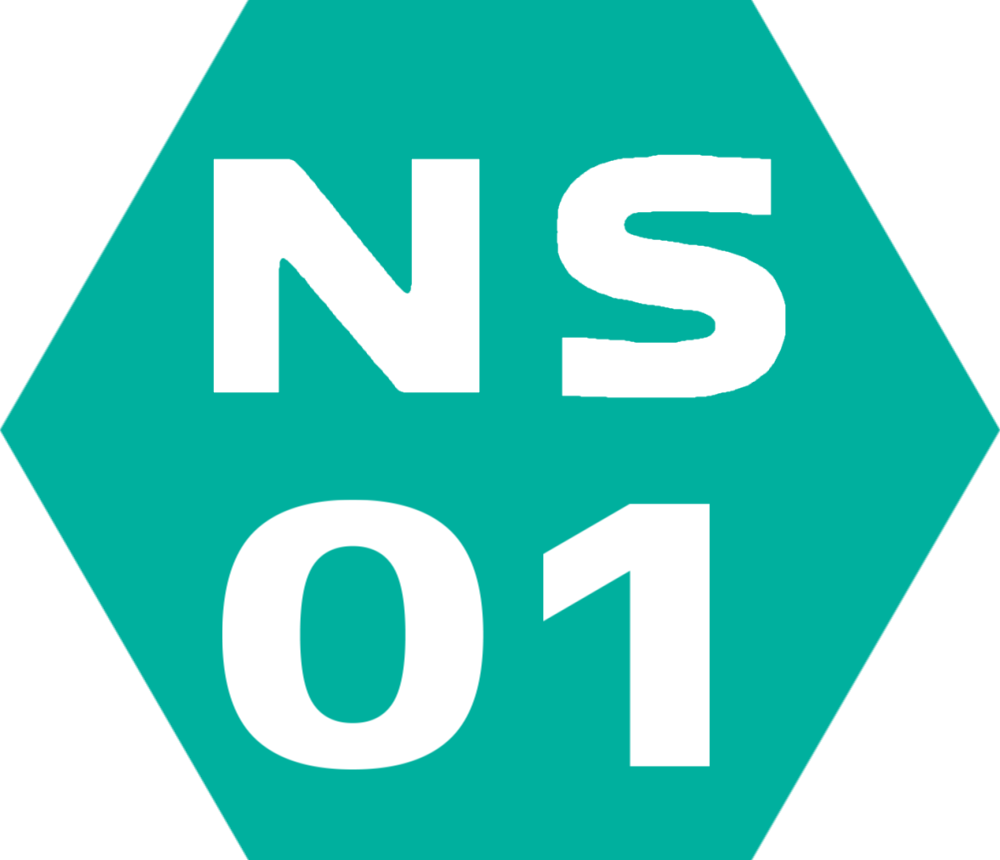|
Super View Odoriko
is a limited express train service in Japan operated by the East Japan Railway Company (JR East), Central Japan Railway Company (JR Central), Izukyu Corporation, and Izuhakone Railway, which runs between and or in Shizuoka Prefecture. Summary The ''Odoriko'' started service from October 1981, with the then-new 185 series rolling stock, replacing the earlier ''Amagi'' limited express (run by the 183 series) and the ''Izu'' express (run by the 153 series). After that, the ''Super View Odoriko'' also operated from April 1990 to 13 March 2020, with the 251 series rolling stock. On 14 March 2020, ''Saphir Odoriko'' started service using E261 series EMUs. Regular services ''Odoriko'' Three services operate back and forth every day between Tokyo and Izukyū Shimoda Station along the Tōkaidō Main Line, Itō Line, and Izu Kyūkō Line, two of which are coupled with services that go to Shuzenji along the Izuhakone Railway Sunzu Line (decoupled at ). Vending services are ava ... [...More Info...] [...Related Items...] OR: [Wikipedia] [Google] [Baidu] |
Limited Express
A limited express is a type of express train or express bus service that stops at fewer locations compared to other express services on the same or similar routes. Japan The term "limited express" is a common translation of the Japanese compound noun ; ; often abbreviated as , though some operators translate the word differently. There are two types of limited express trains: inter-city rail, intercity, and commuter rail, commuter. The former type of limited express trains generally use long-distance coaches, equipped better than other ordinary express trains, including reserved seating, dining cars, food and beverage cars, and "green cars" (first class cars). The latter type of limited express train usually incurs no surcharge, but seating is usually first-come, first-served, since this type of train uses commuter train coaches. Both types of trains travel faster and stop at fewer stations. Until 1972, the ''Hikari (train), Hikari'' on the Tōkaidō Shinkansen was offic ... [...More Info...] [...Related Items...] OR: [Wikipedia] [Google] [Baidu] |
183 Series
The was a Japanese limited express electric multiple unit (EMU) train type introduced in 1972 by Japanese National Railways (JNR). Following the privatization of JNR, the 183 series was operated by East Japan Railway Company (JR East) and West Japan Railway Company (JR-West). In terms of design, it is closely based on the late-model AC/DC 485 series, with minor cosmetic differences and DC-only drive. The last 189 series sets were withdrawn on 29 March 2019. The trains were built by Hitachi, Kawasaki Heavy Industries, Kinki Sharyo, Nippon Sharyo, and Tokyu Car Corporation. Former operations JR East * '' Azusa'' (seasonal only) * ''Kaiji'' (seasonal only) * ''Wing'' * '' Moonlight Shinshū'' * '' Moonlight Nagara'' * '' Sazanami'' * '' Wakashio'' * '' Shiosai'' * '' Ayame'' * '' Suigo'' * '' Toki'' * '' Amagi'' * '' Odoriko'' * '' Asama'' * '' Myōkō'' * '' Ohayō Liner'' * '' Chūō Liner'' (until March 2008) * '' Ōme Liner'' (until June 2002) JR-West The 183 series tr ... [...More Info...] [...Related Items...] OR: [Wikipedia] [Google] [Baidu] |
Kawasaki Station
is a junction passenger railway station located in the city of Kawasaki, Kanagawa, Japan, operated by East Japan Railway Company (JR East). Lines Kawasaki Station is served by the following JR East lines. The station is from and from . Station layout The station has three elevated island platforms serving six tracks, with an elevated station building built into a shopping center. The station has a ''Midori no Madoguchi'' staffed ticket office. Platforms File:JR_Kawasaki_Station_Platform_1・2_(20210418).jpg, Platforms 1 and 2 File:JR_Kawasaki_Station_Platform_3・4_(20210418).jpg, Platforms 3 and 4 File:JR_Kawasaki_Station_Platform_5・6.jpg, Platforms 5 and 6 The song "Ue o Muite Arukou" (上を向いて歩こう, ''Ue wo Muite Arukou''), commonly known worldwide as "Sukiyaki (song), Sukiyaki" by Kyu Sakamoto, born in Kawasaki, is used as the Train melody, departure melody for Platforms 1 and 2. History The station opened on 10 July 1872 (June 5 in original Jap ... [...More Info...] [...Related Items...] OR: [Wikipedia] [Google] [Baidu] |
Shinagawa Station
is a major railway station in the Takanawa and Konan districts of Minato, Tokyo, Japan, operated by East Japan Railway Company (JR East), Central Japan Railway Company (JR Central), and the private railway operator Keikyu. The Tokaido Shinkansen and other trains to the Miura Peninsula, Izu Peninsula, and the Tōkai region pass through here. Though a major station in Tokyo, Shinagawa is not served by the Tokyo subway network. However, it is connected to the Toei Asakusa Line via Keikyu through services. Despite its name, the station is not located in Shinagawa ward. ''Shinagawa'' is also commonly used to refer to the business district around the station, which is in Takanawa and Konan neighborhoods of Minato, directly north of Shinagawa ward. This station is just south of a large yard complex consisting of Shinagawa Carriage Sidings, Shinagawa Locomotive Depot, and Tamachi Depot. Lines Shinagawa is served by the following lines: JR Central * Tokaido Shinkansen JR East * * ... [...More Info...] [...Related Items...] OR: [Wikipedia] [Google] [Baidu] |
Tokyo Station
Tōkyō Station (, ) is a major railway station in Chiyoda, Tokyo, Japan. The original station is located in Chiyoda's Marunouchi business district near the Tokyo Imperial Palace, Imperial Palace grounds. The newer Eastern extension is not far from the Ginza commercial district. Due to the large area covered by the station, it is divided into the Marunouchi (west) and Yaesu (east) sides in its directional signage. The station opened in 1914 as an integrated terminus for the present-day Tōkaidō Main Line, Tōkaidō Line, Tōhoku Main Line, Tōhoku Line, and later the Chūō Main Line, Chūō Line, which previously had separate termini in Tokyo. Since then, it has served as the main terminus for inter-city trains departing Tokyo westwards. The station was badly damaged during the Bombing of Tokyo on 25 May 1945 but soon resumed service. The Tokaido Shinkansen, Tōkaidō Shinkansen, the world’s first dedicated high-speed rail system, opened between the station and Osaka in 196 ... [...More Info...] [...Related Items...] OR: [Wikipedia] [Google] [Baidu] |
Utsunomiya Line
The Utsunomiya Line () is the name given to a section of the Tōhoku Main Line between Tokyo Station in Tokyo and Kuroiso Station in Nasushiobara, Tochigi, Japan. It is part of the East Japan Railway Company (JR East) network. Services Services on the Utsunomiya Line are typically divided into three categories: services to or from Ueno, Shōnan–Shinjuku Line services, and Ueno–Tokyo Line services. Between Ueno and Ōmiya, trains share the track with the Takasaki Line, both of which serve as ''de facto'' express services compared to the parallel Keihin–Tōhoku Line. Northbound services mostly terminate at or , with some at . Southbound trains mostly travel through the Shōnan–Shinjuku Line to on the Yokosuka Line, or the Ueno–Tokyo Line to on the Tōkaidō Line, with a few trains terminating at Ueno. The fastest service on the line, the rapid ''Rabbit'', makes the run between Ueno and Utsunomiya in 1 hour and 26 minutes. Service on the line is generally divided ... [...More Info...] [...Related Items...] OR: [Wikipedia] [Google] [Baidu] |
Ōmiya Station (Saitama)
is a major interchange railway station in Ōmiya-ku, Saitama, Japan, jointly operated by East Japan Railway Company (JR East), Saitama New Urban Transit and private railway operator Tōbu Railway. It is the busiest JR East station in Saitama Prefecture. Lines The following lines serve the station: JR East * Tōhoku Shinkansen * Hokkaidō Shinkansen * Yamagata Shinkansen * Akita Shinkansen * Jōetsu Shinkansen * Hokuriku Shinkansen * Tōhoku Main Line (Utsunomiya Line) * Takasaki Line * Shōnan-Shinjuku Line * Ueno-Tokyo Line * Keihin-Tōhoku Line * Saikyō Line * Kawagoe Line Tobu Railway * Tobu Urban Park Line Saitama New Urban Transit * 22px New Shuttle Station layout JR East platforms No. 1–11 File:JRE Omiya-STA Central-Gate-South.jpg, Central south gate in July 2022 File:JRE Omiya-STA Central-Gate-North.jpg, Central north gate in July 2022 File:JRE Omiya-STA South-Gate.jpg, South gate in July 2022 File:JRE Omiya-STA North-Gate.jpg, North g ... [...More Info...] [...Related Items...] OR: [Wikipedia] [Google] [Baidu] |
Jōban Line
The is a railway line in Japan operated by the East Japan Railway Company (JR East). The line officially begins at Nippori Station in Arakawa, Tokyo before the line officially ends at Iwanuma Station in Iwanuma, Miyagi. However, following the opening of the Ueno–Tokyo Line, Jōban Line train services originate at or ; likewise, Jōban Line trains continue past Iwanuma onto the Tōhoku Main Line tracks to . The line approximately parallels the Pacific coasts of Chiba, Ibaraki, and Fukushima Prefectures. The name "Jōban" is derived from the names of the former provinces of Hitachi (), and Iwaki (), which are connected by the line to reach Tokyo. The section of the Jōban Line between and , which extends through the exclusion zone surrounding the Fukushima Daiichi nuclear meltdown, closed in the wake of the 2011 Tōhoku earthquake and tsunami and Fukushima Daiichi nuclear disaster. After some major repairs, the section reopened on 14 March 2020 after 9 years without ... [...More Info...] [...Related Items...] OR: [Wikipedia] [Google] [Baidu] |
Abiko Station (Chiba)
is a junction passenger railway station in the city of Abiko, Chiba Prefecture Japan, operated by East Japan Railway Company (JR East). Lines Abiko is served by both the Jōban Line and the Narita Line. It is 31.3 km from the terminus of the Jōban Line at Ueno Station in Tokyo, and forms the terminus for the Abiko Branch Line of the Narita Line. Layout The station is an elevated station with three island platforms and one side platform serving seven tracks. The station has a "Midori no Madoguchi" staffed ticket office. Platforms History Abiko Station opened on 25 December 1896. With the privatization of Japanese National Railways The , abbreviated JNR or , was the business entity that operated Japan's national railway network from 1949 to 1987. Network Railways As of June 1, 1949, the date of establishment of JNR, it operated of narrow gauge () railways in all 46 pre ... (JNR) on 1 April 1987, the station came under the control of JR East. Passenger ... [...More Info...] [...Related Items...] OR: [Wikipedia] [Google] [Baidu] |
Ueno–Tokyo Line
The Ueno–Tokyo Line (), formerly known as the Tōhoku Through Line () is a railway line in Tokyo, Japan, operated by the East Japan Railway Company (JR East), linking Ueno Station and Tokyo Station, extending the services of the Utsunomiya Line, the Takasaki Line, and the Jōban Line southward and onto the Tōkaidō Main LineJR East Annual Report 2010 retrieved 2013-12-09 and vice versa. While on official maps the line is purple, rolling stock and signage show the line as orange stacked on green to reflect the through-running nature of services on these respective lines. The project began in May 2008 and was opened with the 14 March 2015 timetable revision, costing about JPY 40 billion. Direct ... [...More Info...] [...Related Items...] OR: [Wikipedia] [Google] [Baidu] |
Shōnan–Shinjuku Line
The Shōnan–Shinjuku Line () is a passenger railway service in Japan which commenced in December 2001. The line has no dedicated track as services run through shared sections along the Ryōmō Line, Takasaki Line, Utsunomiya Line, Yamanote freight line, Yokosuka Line, and Tōkaidō Main Line. It is treated as a distinct service at stations and on railway maps. Services Service patterns on the Shōnan–Shinjuku Line are as follows: Utsunomiya Line–Yokosuka Line route * Shōnan–Shinjuku Line local (Utsunomiya Line: local; Ōmiya–Ōfuna: local; Yokosuka Line: local) ** Services commenced on December 1, 2001. ** One train per hour is operated between (some to/from ) and ; this increases to 2–3 trains per hour during peak periods. Sometimes trains operate to/from Ōfuna as well as to/from on weekday mornings. ** Most trains are operated in 15-car sets. Some pause at Koganei to couple-up or divide, with the 10-car portion continues northward; others are operated in 10- ... [...More Info...] [...Related Items...] OR: [Wikipedia] [Google] [Baidu] |
Izuhakone Railway Sunzu Line
The is a commuter railway line of the Izuhakone Railway, a private railroad in Japan. The line connects Mishima Station in the city of Mishima with Shuzenji Station in the city of Izu, both within Shizuoka Prefecture. The name "Sunzu" comes from the former provinces of Suruga and Izu, although the line at present operates only within the borders of former Izu Province. Stations Limited Express ''Odoriko'' The '' Odoriko'' runs two services on weekdays and three services on holidays on the Sunzu Line. Previously using 185 series sets, E257-2000/2500 series trains were introduced by JR East in 2021. A limited express ticket is required to board the ''Odoriko''. History The Sunzu Line opened for operations on May 20, 1898, connecting Zuso-Mishima Station (present-day Mishima-Tamachi Station) with Nanjō Station (present-day Izu-Nagaoka Station). The terminus of the line was moved to Mishima Station (present-day Shimo-Togari Station) on June 15, 1898, and the southern e ... [...More Info...] [...Related Items...] OR: [Wikipedia] [Google] [Baidu] |






